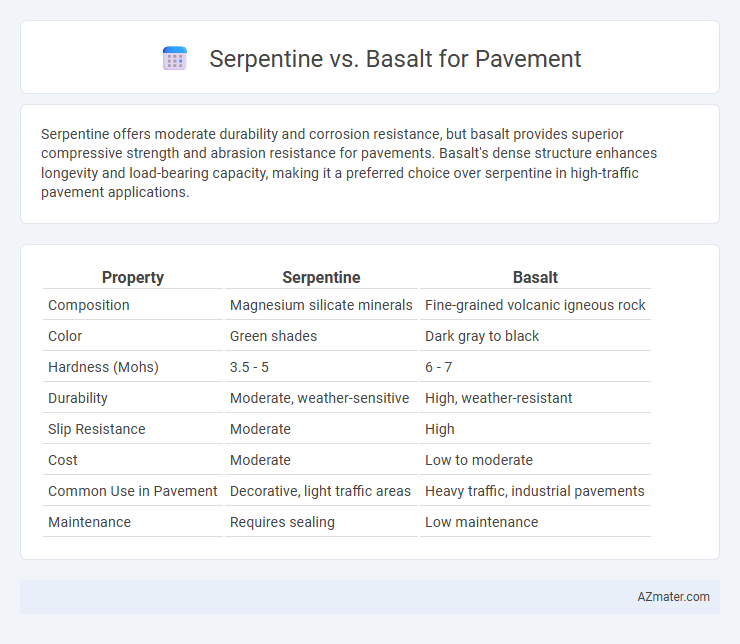Serpentine offers moderate durability and corrosion resistance, but basalt provides superior compressive strength and abrasion resistance for pavements. Basalt's dense structure enhances longevity and load-bearing capacity, making it a preferred choice over serpentine in high-traffic pavement applications.
Table of Comparison
| Property | Serpentine | Basalt |
|---|---|---|
| Composition | Magnesium silicate minerals | Fine-grained volcanic igneous rock |
| Color | Green shades | Dark gray to black |
| Hardness (Mohs) | 3.5 - 5 | 6 - 7 |
| Durability | Moderate, weather-sensitive | High, weather-resistant |
| Slip Resistance | Moderate | High |
| Cost | Moderate | Low to moderate |
| Common Use in Pavement | Decorative, light traffic areas | Heavy traffic, industrial pavements |
| Maintenance | Requires sealing | Low maintenance |
Introduction to Serpentine and Basalt as Pavement Materials
Serpentine and basalt are commonly used materials for pavement due to their durability and aesthetic qualities. Serpentine is a metamorphic rock known for its smooth texture and greenish hues, offering good slip resistance and weathering properties. Basalt, an igneous rock, is prized for its high compressive strength and abrasion resistance, making it suitable for heavy traffic areas and long-lasting pavement surfaces.
Geological Origins of Serpentine and Basalt
Serpentine originates from the metamorphic transformation of ultramafic rocks, primarily peridotite, in subduction zones where oceanic plates descend beneath continental plates, causing hydration and low-grade metamorphism. Basalt forms from the rapid cooling of low-viscosity lava at mid-ocean ridges or volcanic hotspots, representing extrusive igneous rock rich in iron and magnesium. Understanding these distinct geological processes highlights serpentine's metamorphic origin and basalt's igneous volcanic origin, crucial for their differing durability and texture in pavement applications.
Physical and Mechanical Properties: Serpentine vs Basalt
Serpentine exhibits lower compressive strength and abrasion resistance compared to basalt, making basalt more durable for high-traffic pavement applications. Basalt's higher density and superior load-bearing capacity enhance its mechanical performance under heavy loads, whereas serpentine's softer texture results in quicker wear and tear. The distinct mineral compositions contribute to basalt's enhanced hardness and resistance to weathering, positioning it as a preferred material for long-lasting pavement surfaces.
Durability and Weather Resistance Comparison
Serpentine pavement offers moderate durability with good resistance to weathering but is more prone to erosion and chemical breakdown compared to basalt. Basalt, known for its high density and fine-grained structure, provides superior durability and exceptional resistance to freeze-thaw cycles, abrasion, and acidic environments. These properties make basalt a preferred choice for long-lasting pavement in harsh weather conditions.
Cost and Availability in Pavement Applications
Serpentine is generally more affordable and widely available in regions with abundant ultramafic rock formations, making it a cost-effective choice for pavement applications. Basalt, although often more expensive due to quarrying and transportation costs, offers superior durability and skid resistance, justifying its higher price in high-traffic areas. Availability of basalt can be limited in some regions, influencing cost and logistics for large-scale pavement projects.
Environmental Impacts of Serpentine and Basalt
Serpentine and basalt differ significantly in their environmental impacts when used for pavement. Serpentine contains naturally occurring asbestos and heavy metals like nickel and chromium, which can pose health risks and require careful handling and disposal to avoid environmental contamination. Basalt, being a volcanic rock with low harmful mineral content, offers a more environmentally friendly choice by minimizing hazardous emissions and reducing soil and water pollution during quarrying and installation.
Safety Considerations: Skid Resistance and Heat Retention
Serpentine and basalt differ significantly in safety considerations for pavement, particularly in skid resistance and heat retention. Basalt provides superior skid resistance due to its rough texture and high hardness, reducing the risk of vehicular accidents in wet conditions. Serpentine, while more heat-retentive, can become slippery when wet and retains heat longer, potentially affecting pavement durability and user safety during hot weather.
Installation and Maintenance Requirements
Serpentine pavement installation requires specialized cutting and handling due to its softer texture, which can simplify initial placement but demands careful sealing to prevent weathering. Basalt, being a dense and highly durable volcanic rock, offers more straightforward installation with heavy machinery and requires minimal maintenance because of its resistance to wear and harsh environmental conditions. Maintenance for serpentine surfaces often involves frequent sealing and repair of cracks to preserve integrity, whereas basalt pavements tend to resist abrasion and chemical damage, resulting in lower long-term upkeep costs.
Real-World Case Studies and Performance Data
Serpentine and basalt pavements have been extensively compared in real-world case studies, with basalt demonstrating superior durability and abrasion resistance in high-traffic urban settings due to its dense, fine-grained structure. Performance data from municipal road projects reveal that basalt pavements exhibit lower maintenance costs and longer service life, averaging over 30 years under heavy load conditions, whereas serpentine pavements show increased susceptibility to weathering and mechanical wear within 15-20 years. These findings underscore basalt's effectiveness for sustainable infrastructure, especially in climates with frequent freeze-thaw cycles and heavy vehicular stress.
Choosing the Best Stone: Serpentine vs Basalt for Pavement
Basalt is renowned for its exceptional durability and high compressive strength, making it ideal for heavy-traffic pavement applications, while serpentine offers aesthetic appeal with its rich green hues but is generally softer and less resistant to wear. The choice between serpentine and basalt for pavement depends on balancing visual preferences with performance requirements, as basalt provides superior resistance to abrasion and weathering. For long-lasting, low-maintenance surfaces in demanding environments, basalt is the preferred stone, whereas serpentine suits decorative or light-use pavements where appearance is prioritized.

Infographic: Serpentine vs Basalt for Pavement
 azmater.com
azmater.com